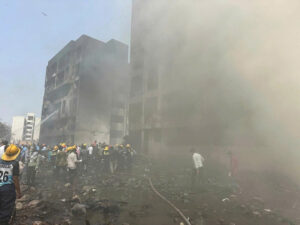Lift vs. Power – What Really Happened to AI171? | Captain Steeeve Reacts
Published: June 14, 2025
🛫 When Flight AI171 Fell: Questions Multiply
As investigators comb through the wreckage of Air India Flight AI171, which went down shortly after takeoff from Ahmedabad Airport on June 12, global aviation experts are stepping forward with early insights — and questions.
One topic is gaining traction across forums and flight analysis channels: Did AI171 lose lift… or lose power?
Enter Captain Steeeve, a former commercial pilot and now one of the most-followed aviation explainers on YouTube. In a detailed 19-minute video posted on June 13, titled “AI171 – A Case of Lost Lift or Power?”, Captain Steeeve breaks down what he believes is the crucial moment in the aircraft’s final trajectory — and why it may not be as simple as a single-system failure.
“This isn’t just about engines. This may have been about physics,” he explains in the video. “You can have power, but without lift, you’re coming down — hard.”
📉 Reconstructing the Final Minutes
According to early flight data and ATC radar logs (as referenced by Republic TV and The Times of India), Flight AI171 took off from Runway 23L at 13:38 local time, cleared for departure with no apparent delay.
The Boeing 787-8 Dreamliner began a normal climb for the first 90 seconds.
Around 625 feet above ground level (AGL), the plane lost altitude rapidly.
A distress call was issued seconds before disappearing from radar.
Within minutes, it crashed into a residential building in the Meghani Nagar neighborhood.
📺 Related: Watch the Video Clip of AI171’s Descent
🧠 Captain Steeeve’s Theory: Lift Lost, Not Just Power
In his analysis, Captain Steeeve rules out an immediate dual engine failure, citing no early signs of smoke trails or fire at takeoff.
Instead, he points to a possible aerodynamic issue affecting lift — the upward force that keeps an aircraft flying.
“From the trajectory alone, this looked more like a stall than a flameout. You can lose one engine and stay airborne. But if your wings stop generating lift due to angle of attack issues or airflow disruption, you’re going down fast,” he says.
In other words: AI171 may have still had thrust — but not enough aerodynamic stability to keep climbing.
🧪 Lift vs. Power: What’s the Difference?
Let’s break it down simply:
Power (Thrust) = What engines provide to move the plane forward
Lift = What wings generate to push the plane upward, opposing gravity
You can have engines at full throttle, but if airflow is disrupted (e.g., due to steep pitch, flap configuration errors, or weight imbalance), lift fails, and the aircraft stalls — which is a loss of flight, not a shutdown.
“Pilots are trained to respond to engine failure. But a low-altitude stall? That’s almost unrecoverable if it happens too soon,” says retired captain and accident analyst, Rajiv Marwah.
🔍 The Aircraft: Boeing 787-8 Dreamliner

Flight AI171 was operated by a Dreamliner, a modern twin-engine jet known for fuel efficiency and fly-by-wire technology. Air India has 27 such aircraft in service.
According to Boeing, the 787 has redundant safety systems, including:
Dual flight management computers
Multiple angle-of-attack sensors
Automated stall protection features
However, if key sensors provide incorrect or delayed data, these protections can be compromised — similar to known cases in other aircraft models where sensor faults led to incorrect stall responses.
🗣️ What About Bird Strike or Weight Imbalance?
Online speculation has floated several theories, some of which Captain Steeeve addresses:
❌ Bird Strike?
No known engine ingestion was reported, and no flocks were recorded in the area that day.
❌ Overweight Takeoff?
Passenger load was high, but well within the Dreamliner’s max takeoff capacity (254 vs. max 296). No evidence suggests fuel mismanagement.
❌ Pilot Error?
Still under review. Voice data has not been released, but Air India confirms both pilots had over 12,000 hours of combined flight time.
🎙️ Expert Voices Weigh In
Anjali Rao, aerospace engineer and consultant to European regulators, said in an interview with News18:
“We need to understand whether this was a systems-level issue — one that prevented the aircraft from reading or responding to pitch instability.”
Meanwhile, DGCA Chief Investigator Nandini Suri confirmed that both the flight data recorder (FDR) and cockpit voice recorder (CVR) are undergoing urgent decryption.
“We are looking at multiple contributing factors. No single theory is confirmed at this time,” she said.
🧍 One Survivor, One Critical Account
As reported earlier, Vishwash Kumar Ramesh, the only known survivor from AI171, has offered early testimony indicating a “strong lurch” and “downward nose angle” seconds before impact.
Doctors say he may provide vital details once his condition stabilizes.
🧾 Read: “I Don’t Know How I Got Saved” – Survivor’s Statement
🚧 The Broader Implications
The AI171 incident — the first of its kind involving a 787 Dreamliner in India — has triggered:
Temporary grounding of select Air India Dreamliners
Emergency inspections of flight control software
Renewed global conversations around angle-of-attack system reliability
Aviation regulator EASA and the US FAA have expressed interest in reviewing the investigation outcomes jointly with Indian authorities.
🖥️ Captain Steeeve’s Final Word
Closing out his video, Captain Steeeve issues a powerful reminder to aviation fans and the general public alike:
“Sometimes it’s not about a missing part or a broken wire. It’s physics — and how thin the margins can be. Lift, thrust, drag, and gravity: they never stop working. Even when we do.”
He also urges viewers not to speculate beyond verified data and to respect the investigation process.
🔗 Related Articles and Media:
📊 Explained: What Is Lift Loss in Aviation?
📹 Watch: Air India AI171’s Final Seconds Captured on Camera
🧑✈️ Survivor’s Story: Vishwash Kumar and the Moment Everything Changed
📄 Full Timeline of AI171 Crash Investigation
🎥 YouTube: Captain Steeeve Breaks Down AI171
This article is part of News18’s in-depth reporting on the Air India AI171 aviation incident. For verified updates and expert commentary
News
“Has It Really Come to This?” — Bianca Gonzalez Threatened Over PBB ‘Scripted’ Claims (NH)
“Has It Really Come to This?” — Bianca Gonzalez Threatened Over PBB ‘Scripted’ Claims Manila, Philippines — Pinoy Big…
Kris Aquino’s Son Bimby Mistaken for Philip Salvador’s Son—‘Super Pogi’ and Resembling His Father Ipe (NH)
Kris Aquino’s Son Bimby Mistaken for Philip Salvador’s Son—‘Super Pogi’ and Resembling His Father Ipe Manila, Philippines — In…
Arci Muñoz and Gerald Anderson Reveal DNA Test Results—Their Child! Julia Barretto Shocked! (NH)
Arci Muñoz and Gerald Anderson Reveal DNA Test Results—Their Child! Julia Barretto Shocked! Manila, Philippines — In a surprising…
Dani Barretto Sends Meaningful Message to Julia Barretto After Breakup with Gerald Anderson (NH)
Dani Barretto Sends Meaningful Message to Julia Barretto After Breakup with Gerald Anderson Manila, Philippines — In the midst…
Lotlot De Leon Opens Up About Meeting Her Mother Nora Aunor While John Randez Posts on Social Media (NH)
Lotlot De Leon Opens Up About Meeting Her Mother Nora Aunor While John Randez Posts on Social Media Manila,…
Tom Rodriguez and New Wife Spotted in Tagaytay; Carla Abellana’s More Decent Look Revealed? (NH)
Tom Rodriguez and New Wife Spotted in Tagaytay; Carla Abellana’s More Decent Look Revealed? Tagaytay, Philippines — Filipino actor…
End of content
No more pages to load












